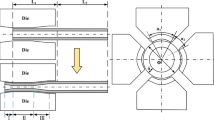Abstract
In this study, the artificial neural network (ANN) and the Taguchi method are employed to optimize the radial force and strain inhomogeneity in radial forging process. The finite element analysis of the process verified by the microhardness test (to confirm the predicted strain distribution) and the experimental forging load published by the previous researcher are used to predict the strain distribution in the final product and the radial force. At first, a combination of process parameters are selected by orthogonal array for numerical experimenting by Taguchi method and then simulated by FEM. Then the optimum conditions are predicted via the Taguchi method. After that, by using the FEM results, an ANN model was trained and the optimum conditions are predicted by means of ANN (using genetic algorithm as global optimization procedure) and compared with those achieved by the Taguchi method. The optimum conditions are verified by FEM, and good agreement is found between the two sets of results.
Similar content being viewed by others
References
Altan T, Oh SI, Gegel H (1983) Metal forming fundamentals and applications. American Society for Metals Materials Park 17:31–35
Yano H, Akshi T (1994) Application of analytical simulation to forged part design. Toyota Tech Rev 43(2):20–25
Jang DY, Liou JH (1998) Study of stress development in axi-symmetric products processed by radial forging using a 3-D non-linear finite-element method. J Mater Process Technol 74:74–82
Ko D-C, Kim D-H, Kim B-M (1999) Application of artificial neural network and Taguchi method to preform design in metal forming considering workability. Int J Mach Tools Manuf 39:771–785
Lahoti GD, Altan T (1976) Analysis of the radial forging process for manufacturing of rods and tubes. J Eng Ind 98:265–271
Lahoti GD, Dembowski PV, Altan T (1976) Radial forging of tubes and rods with compound-angle dies. Proceeding of NAMRC-IV Columbus Ohio May 17–19:87–95
Subramanian TL, Venkateshwar R, Lahoti GD, Lee FM (1978 and 1979) Experimental and computer modeling of die cavity fill in radial forging of rifling. Proceeding of process modeling sessions, Process modeling - Fundamentals and applications to metals USA:66–72
Tszeng TC, Kobayashi S (1986) Determination of residual stresses in radial forging, Manufacturing Processes Simulation. PED-20:31–45
Domblesky JP, Shivpuri R, Painter B (1995) Application of the finite-element method to the radial forging of large diameter tubes. J Mater Process Technol 49:57–74
Domblesky JP, Shivpuri R (1995) Development and validation of a finite-element model for multiple-pass radial forging. J Mater Process Technol 55:432–441
Jang DY, Liou JH (1998) Study of stress development in axi-symmetric products processed by radial forging using a 3-D non-linear finite-element method. J Mater Process Technol 74:74–88
Lee KH, Lee SR, Yang DY (2004) Rigid-plastic finite element analysis of incremental radial forging process using the automatic expansion of domain scheme. Eng Computations 21(5):470–487
Ghaei A, Movahhedy MR, Karimi Taheri A (2005) Application of 3D FEM to die design in the radial forging process. TICME2005, Tehran, Iran :112–120
Rodic T, Owen DRJ (1987) Basic concepts of numerical simulation of a radial forging process. Zezb 214:167–174
Shimizu T, Ohuchi K, Sano T (1990) Reducing of circular bars by a multi ram forging machine. J JSTP 31:392–397
Thompson EG, Hamzeh O, Jackman LA, Srivatsa SK (1992) A quasi-steady-state analysis for radial forging. J Mater Process Techno 34:1–8
Jackman LA, Ramesh MS, Forbes-Jones R (1992) Development of a finite element model for radial forging of superalloys. Proc Int Sym on the Metallurgy and Applications of superalloys, Pittsburgh:103–112
Domblesky JP, Shivpuri R, Mohamdein N (1994) FEM simulation of multiple pass radial forging of pyromet. Proceeding of the Int Symposium, Pittsburg:26–29
Humphreys FJ, Hatherly M (1995) Recrystallization and related annealing phenomena, vol 11. Elsevier Science, Oxford, p 15
Lindh E, Hutchinson B, Ueyama S (1993) Effect of redundant deformation on recrystalization behaviour of copper. Scripta Metall 29:347–352
Chin RK, Steif PS (1995) A computational study of strain inhomogeneity in wire drawing. Int J Mach Tools Manuf 35:1087–1098
Kazeminezhad M, Karimi Taheri A (2006) Deformation Inhomogeneity in Flattened Copper Wire. DOI 10.1016/j.matdes.2006.06.009
Chun MS, Biglou J, Lenard JG, Kim JG (1999) Using neural networks to predict parameters in the hot working of aluminum alloys. J Mater Process Techno 86:245–251
Bahrami A, Mousavi Anijdan SH, Madaah Hosseini HR, Shafyei A, Narimani R (2005) Effective parameters modeling in compression of an austenitic stainless steel using artificial neural network. Comput Mater Sci 34:335–341
Kim DJ, Kim BM (2000) Application of neural network and FEM for metal forming Processes. Int J of Mach Tools Manuf 40:911–925
Taguchi G (1986) Introduction to quality engineering, designing quality into products and processes. Asian Productivity Organization, Japan
Duan X, Sheppard T (2002) Influence of forming parameters on the final subgrain size during hot rolling of aluminium alloys. J Mater Process Technol 130–131:245–249
Roy RK (2001) Design of experiments using the Taguchi approach. John Wiley and Sons, USA
Sadok L, Luksza J, Majta J (1994) Inhomogeneity of mechanical properties in stainless steel rods after drawing. J Mater Process Technol 44:129–141
Petruska J, Janicek L(2003) On the evaluation of strain inhomogeneity by hardness measurement of formed products. J Mater Process Tech 143–144:300–305
Ross PJ (1996) Taguchi techniques for quality engineering, 2nd edn. Tata McGraw-Hill, New Delhi
Author information
Authors and Affiliations
Corresponding author
Rights and permissions
About this article
Cite this article
Sanjari, M., Taheri, A.K. & Movahedi, M.R. An optimization method for radial forging process using ANN and Taguchi method. Int J Adv Manuf Technol 40, 776–784 (2009). https://doi.org/10.1007/s00170-008-1371-2
Received:
Accepted:
Published:
Issue Date:
DOI: https://doi.org/10.1007/s00170-008-1371-2




